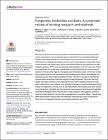| dc.contributor.author | Stout, Jane | |
| dc.contributor.author | Cullen, Merissa G. | |
| dc.contributor.author | Thompson, Linzi J. | |
| dc.contributor.author | Carolan, James C. | |
| dc.contributor.author | Stanley, Dara A. | |
| dc.date.accessioned | 2020-04-15T13:42:10Z | |
| dc.date.available | 2020-04-15T13:42:10Z | |
| dc.date.issued | 2019 | |
| dc.date.submitted | 2019 | en |
| dc.identifier.citation | Cullen, M.G., Thompson, L.J., Carolan, J.C., Stout, J.C. & Stanley, D.A., Fungicides, herbicides and bees: A systematic review of existing research and methods, PLOS ONE, 14, 12, 2019, 1-17 | en |
| dc.identifier.other | Y | |
| dc.identifier.uri | https://journals.plos.org/plosone/article?id=10.1371/journal.pone.0225743 | |
| dc.identifier.uri | http://hdl.handle.net/2262/92291 | |
| dc.description | PUBLISHED | en |
| dc.description.abstract | Bees and the pollination services they deliver are beneficial to both food crop production, and for reproduction of many wild plant species. Bee decline has stimulated widespread interest in assessing hazards and risks to bees from the environment in which they live. While there is increasing knowledge on how the use of broad-spectrum insecticides in agricultural systems may impact bees, little is known about effects of other pesticides (or plant protection products; PPPs) such as herbicides and fungicides, which are used more widely than insecticides at a global scale. We adopted a systematic approach to review existing research on the potential impacts of fungicides and herbicides on bees, with the aim of identifying research approaches and determining knowledge gaps. While acknowledging that herbicide use can affect forage availability for bees, this review focussed on the potential impacts these compounds could have directly on bees themselves. We found that most studies have been carried out in Europe and the USA, and investigated effects on honeybees. Furthermore, certain effects, such as those on mortality, are well represented in the literature in comparison to others, such as sub-lethal effects. More studies have been carried out in the lab than in the field, and the impacts of oral exposure to herbicides and fungicides have been investigated more frequently than contact exposure. We suggest a number of areas for further research to improve the knowledge base on potential effects. This will allow better assessment of risks to bees from herbicides and fungicides, which is important to inform future management decisions around the sustainable use of PPPs. | en |
| dc.format.extent | 1-17 | en |
| dc.language.iso | en | en |
| dc.publisher | Public Library of Science | en |
| dc.relation.ispartofseries | PLOS ONE; | |
| dc.relation.ispartofseries | 14; | |
| dc.relation.ispartofseries | 12; | |
| dc.rights | Y | en |
| dc.subject | Bees | en |
| dc.subject | Herbicides | en |
| dc.subject | Fungicides | en |
| dc.subject | Honey bees | en |
| dc.subject | Insecticides | en |
| dc.subject | Pesticides | en |
| dc.subject | Pollen | en |
| dc.subject | Bumblebees | en |
| dc.title | Fungicides, herbicides and bees: A systematic review of existing research and methods | en |
| dc.type | Journal Article | en |
| dc.type.supercollection | scholarly_publications | en |
| dc.type.supercollection | refereed_publications | en |
| dc.identifier.peoplefinderurl | http://people.tcd.ie/stoutj | |
| dc.identifier.rssinternalid | 209723 | |
| dc.identifier.doi | http://dx.doi.org/10.1371/journal.pone.0225743 | |
| dc.rights.ecaccessrights | openAccess | |
| dc.identifier.orcid_id | 0000-0002-2027-0863 | |




